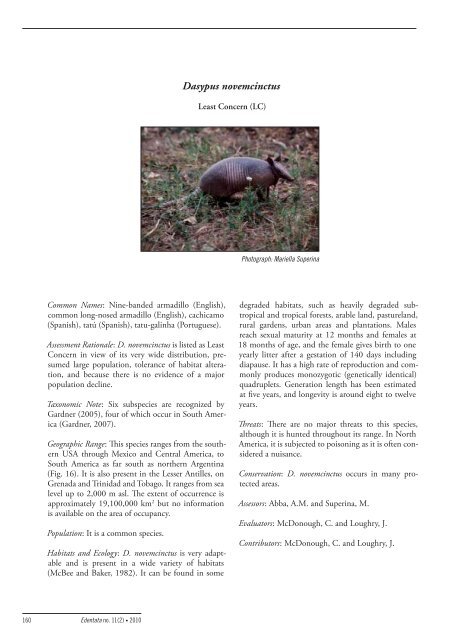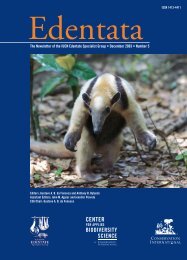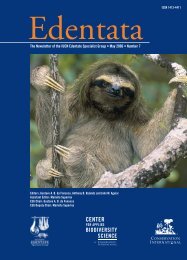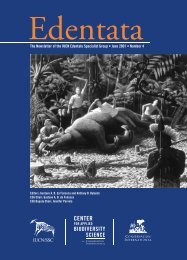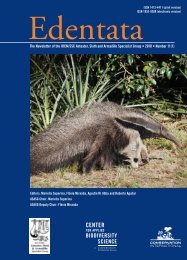Edentata 11(2), 2010 - Anteater, Sloth & Armadillo Specialist Group
Edentata 11(2), 2010 - Anteater, Sloth & Armadillo Specialist Group
Edentata 11(2), 2010 - Anteater, Sloth & Armadillo Specialist Group
- No tags were found...
Create successful ePaper yourself
Turn your PDF publications into a flip-book with our unique Google optimized e-Paper software.
Dasypus novemcinctusLeast Concern (LC)Photograph: Mariella SuperinaCommon Names: Nine-banded armadillo (English),common long-nosed armadillo (English), cachicamo(Spanish), tatú (Spanish), tatu-galinha (Portuguese).Assessment Rationale: D. novemcinctus is listed as LeastConcern in view of its very wide distribution, presumedlarge population, tolerance of habitat alteration,and because there is no evidence of a majorpopulation decline.Taxonomic Note: Six subspecies are recognized byGardner (2005), four of which occur in South America(Gardner, 2007).Geographic Range: This species ranges from the southernUSA through Mexico and Central America, toSouth America as far south as northern Argentina(Fig. 16). It is also present in the Lesser Antilles, onGrenada and Trinidad and Tobago. It ranges from sealevel up to 2,000 m asl. The extent of occurrence isapproximately 19,100,000 km 2 but no informationis available on the area of occupancy.Population: It is a common species.Habitats and Ecology: D. novemcinctus is very adaptableand is present in a wide variety of habitats(McBee and Baker, 1982). It can be found in somedegraded habitats, such as heavily degraded subtropicaland tropical forests, arable land, pastureland,rural gardens, urban areas and plantations. Malesreach sexual maturity at 12 months and females at18 months of age, and the female gives birth to oneyearly litter after a gestation of 140 days includingdiapause. It has a high rate of reproduction and commonlyproduces monozygotic (genetically identical)quadruplets. Generation length has been estimatedat five years, and longevity is around eight to twelveyears.Threats: There are no major threats to this species,although it is hunted throughout its range. In NorthAmerica, it is subjected to poisoning as it is often considereda nuisance.Conservation: D. novemcinctus occurs in many protectedareas.Assessors: Abba, A.M. and Superina, M.Evaluators: McDonough, C. and Loughry, J.Contributors: McDonough, C. and Loughry, J.160<strong>Edentata</strong> no. <strong>11</strong>(2) • <strong>2010</strong>


